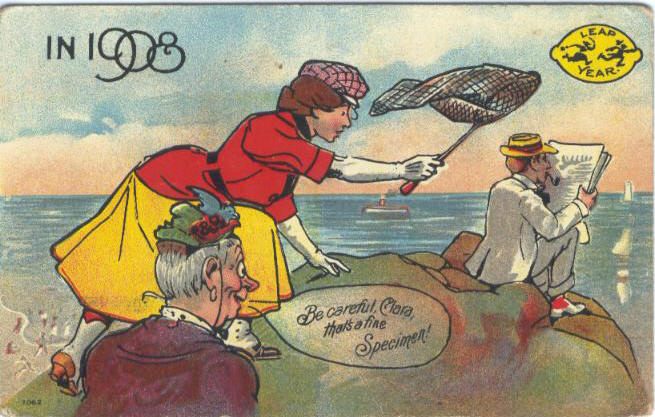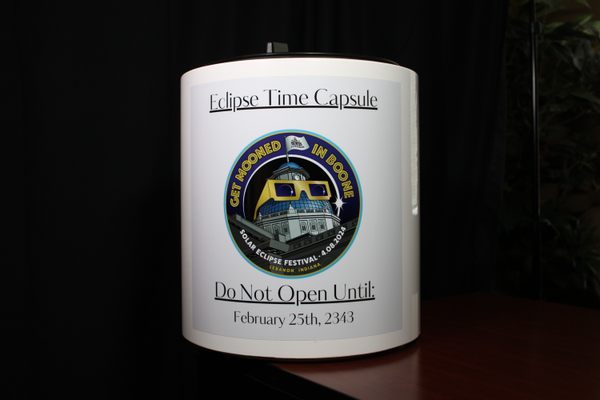For Centuries, Leap Day was the Most Feminist Day on the Calendar
The tradition of women proposing to men on leap day is still popular in Europe.

A 1908 leap day postcard in which a woman attempts to capture a man with a butterfly net. (Photo: Public Domain/Wikipedia Commons)
The cover of the February 21, 1916 edition of the Seattle Star read, “Girls, who’s game to get married? Just propose! We’ll do the rest!” The article promised an all-expenses-paid wedding to any woman who proposed to a man within the next nine days and were wed on February 29.
That’s right: in 1916, a newspaper paid people to get married on leap day.
Sure enough, on February 29th of that year–exactly 100 years ago today–the Seattle Star splashed out for the wedding of one Vesta Ludington to her young man of choice, Alpha Omega Ward. The couple was showered with a wedding banquet, a Tiffany’s ring for the bride, and gifts like life insurance and, better yet, lifetime passes to the movie theater.
This was not the Seattle Star pulling some never-before-heard-of stunt; the tradition of women proposing to men on leap day has been around for centuries.
It is said that the custom originated in Ireland around the fifth century, after St. Brigid complained to St. Patrick that women were forced to wait their whole lives for men to propose to them. The story goes that St. Patrick granted women permission to propose once every seven years, but eventually allowed proposals every leap day.
If the man rejected the woman’s proposal, he was required to buy her a silk gown. The story is dubious, to say the least, because there are claims that St. Brigid would have been a small child when St. Patrick died.

A 1903 cartoon depicts a spinster eagerly awaiting the upcoming leap day. (Photo: Public Domain/Wikipedia Commons)
Another theory is that the tradition began in Scotland in the 12th century, when the unmarried Queen Margaret allegedly enacted a law that allowed a woman “liberty to bespeak ye man she likes” during a leap year. This tale, too, is questionable, given that scholars have not been able to find any such law, and Queen Margaret died at the age of eight on a voyage.
American newspapers recounted these legends throughout the 20th century, but recorded instances of leap year proposals in the country date back as early as the 1780s. By the start of the 20th century, a focus on leap year courtship had emerged, and the custom became a commercial enterprise. It was around this time that various leap day postcards began to appear, that used humor to dissuade women from proposing.
“From 1904 into the 1960s, shame and ridicule made it difficult for women to take advantage of the opportunity to propose to men,” Katherine Parkin explains in “Glittering Mockery”: Twentieth-Century Leap Year Marriage Proposals.
Parkin, however, argues that leap day proposals were far from a feminist occasion–she believes the tradition perpetuated the idea that initiating matrimony was an exclusively male right, and harmed female agency. “Leap year, by virtue of its exceptionalism, reinforced traditional gender roles,” she writes.
The tradition of leap day proposals still exists today, mostly in English-speaking parts of Europe. The dating website match.com recently published an article on its UK site advising women on how to propose to a man on February 29th. Yesterday, the Irish Times published a story where a writer who proposed to her own husband on leap day retroactively worried, “Was I perpetuating the myth that women are such dum-dums that they can propose only on one day every four years?”
No, she eventually concludes, “the gender of the person who gets down on one knee should be inconsequential.” Moreover, the leap day proposal was fun for both of them, and their engagement even trended on Twitter in Ireland.







Follow us on Twitter to get the latest on the world's hidden wonders.
Like us on Facebook to get the latest on the world's hidden wonders.
Follow us on Twitter Like us on Facebook